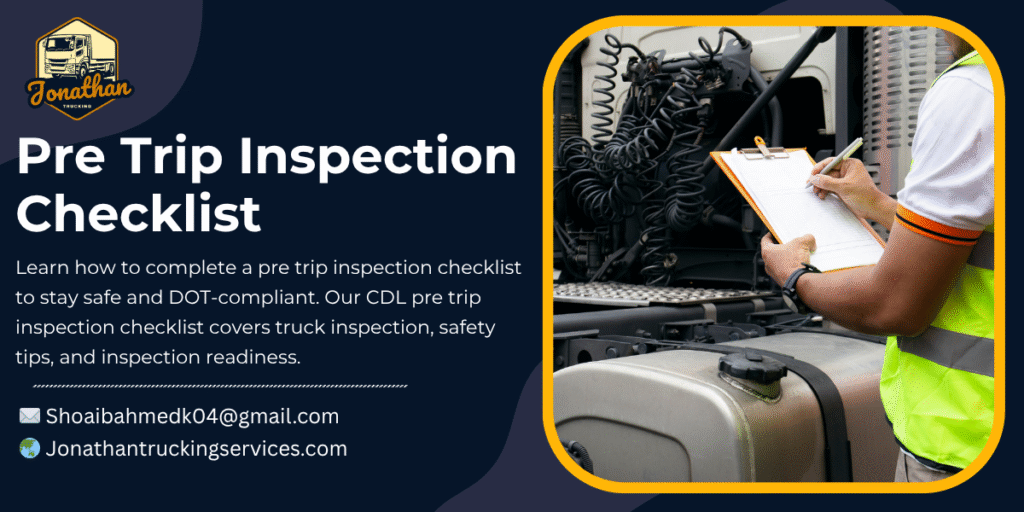
Before every journey, a truck driver’s first responsibility is not to hit the gas—it’s to make sure the vehicle is safe to drive. A thorough pre trip inspection checklist is the most important step in ensuring safety, avoiding costly fines, and staying DOT compliant. For professional drivers, inspection readiness is not just a routine task—it’s a habit that protects lives, careers, and cargo.
In fact, federal regulations require every CDL driver to conduct a detailed inspection before driving. A well-structured truck inspection checklist helps prevent accidents caused by overlooked issues like worn brakes, low tire pressure, or fluid leaks. It also keeps drivers ready for random roadside checks, where inspectors may ask for proof of a completed CDL pre trip inspection checklist.
This guide will cover the importance of pre trip inspections, a step-by-step breakdown of what to check, common mistakes to avoid, and pro tips for inspection readiness. By following this, you’ll gain confidence that your truck is road-ready every single time.
Why a Pre Trip Inspection Checklist Is Essential
A pre trip checklist does much more than check off a box for compliance. It provides:
- Safety Assurance – Identifies issues before they escalate into major hazards.
- DOT Compliance – Keeps you in line with federal and state regulations.
- Reduced Downtime – Prevents costly roadside breakdowns.
- Career Protection – Following a CDL pre trip inspection checklist protects your license.
- Peace of Mind – Knowing your vehicle is in top shape lets you focus on driving.
Skipping or rushing inspections may save a few minutes but can result in hours—or even days—of lost time if your truck fails on the road.
Step-by-Step Pre Trip Inspection Checklist
A proper truck inspection checklist should be systematic, covering every major area of the tractor and trailer. Here’s the breakdown:
1. Engine Compartment
Start with the hood open:
- Fluids: Engine oil, coolant, brake fluid, and power steering should all be within safe limits.
- Belts & Hoses: Inspect for wear, cracks, or leaks.
- Battery: Secure, with no corrosion.
- Leaks: Look under the truck for puddles or drips.
This first step ensures the truck’s heart—the engine—is ready for long miles.
2. Exterior Walk-Around
A quick but detailed walk-around inspection ensures visibility and safety:
- Lights & Reflectors: Check headlights, turn signals, and hazard lights.
- Mirrors & Glass: Clean and adjusted properly.
- Fuel Tank & Caps: No leaks and securely closed.
- Body & Frame: Free from damage or loose parts.
The walk-around portion of the pre trip inspection checklist helps spot issues before they’re overlooked.
3. Tires and Wheels
One of the most important parts of your truck inspection checklist is tire safety:
- Tire Pressure: Check with a gauge, not just by sight.
- Tread Depth: At least 4/32” for steer tires, 2/32” for others.
- Condition: Look for bulges, cuts, or uneven wear.
- Rims & Wheels: No cracks or bends.
- Lug Nuts: All tight and secure.
Proper tire checks prevent blowouts, one of the most common roadside emergencies.
4. Braking System
A functional braking system is critical for safety and DOT inspections:
- Air Brakes: Listen for leaks; check gauges.
- Brake Shoes & Pads: Legal thickness and no contamination.
- Slack Adjusters: Within proper free play limits.
- Hoses & Lines: Free of cracks, leaks, or rubbing damage.
The CDL pre trip inspection checklist emphasizes brakes heavily, so knowing these steps is key to passing tests and roadside checks.
5. Suspension System
Your truck’s suspension absorbs shocks and carries heavy loads:
- Leaf Springs: Not broken, shifted, or missing.
- Shock Absorbers: No leaks, tightly secured.
- Air Bags (if applicable): Inflated and damage-free.
A suspension check ensures load stability and smooth handling.
6. Coupling Devices
For tractor-trailers, coupling must be flawless:
- Fifth Wheel: Properly greased and locked.
- Kingpin & Apron: No cracks or wear.
- Safety Latch: Fully engaged.
- Air & Electrical Lines: Secure and not dragging.
These items are often highlighted in truck inspection checklists to prevent trailer separation accidents.
7. Trailer
The trailer section of the pre trip checklist includes:
- Landing Gear: Fully raised and functional.
- Doors & Hinges: Secure and closing properly.
- Trailer Lights & Reflectors: Clean and operational.
- Tandem Release Arm: Locked in position.
DOT inspectors frequently check trailer safety, so don’t overlook this.
8. In-Cab Inspection
Inside the cab, focus on driver safety and compliance:
- Gauges: Check oil pressure, coolant, and fuel levels.
- Seat Belts: Working and damage-free.
- Horn & Wipers: Fully functional.
- Emergency Equipment: Fire extinguisher, spare fuses, and reflective triangles.
The in-cab portion ensures comfort and quick emergency readiness.
How Long Should a Pre Trip Inspection Take?
A full pre trip inspection checklist usually takes 20–30 minutes. New drivers may take longer, especially when practicing for the CDL pre trip inspection checklist, while experienced drivers can complete inspections efficiently without skipping important steps.
Common Mistakes Drivers Make
Even seasoned drivers sometimes make errors during inspections:
- Skipping Documentation – Failing to log inspections can lead to fines.
- Rushing – Missing small details like lug nuts or reflectors.
- Ignoring Minor Leaks – Small leaks can become big problems quickly.
- Overconfidence – Relying solely on mechanics instead of self-checking.
Avoiding these mistakes improves safety and inspection readiness.
Tips for DOT Inspection Readiness
DOT officers are trained to spot neglected trucks. Here are a few readiness tips:
- Keep your pre trip checklist records in order.
- Maintain a clean cab—inspectors often equate cleanliness with professionalism.
- Always carry required emergency gear.
- Practice your CDL pre trip inspection checklist regularly.
Customizing Your Pre Trip Checklist
While DOT sets standards, drivers can personalize their truck inspection checklist for added safety:
- Seasonal Checks: Winter tires, coolant levels, and heater systems in cold months.
- Technology Tools: Mobile apps can provide digital truck inspection checklists.
- Printed Checklists: A laminated list in the cab acts as a quick reference.
Customization helps build consistency and thoroughness in your inspections.
Conclusion
A successful trucking career depends on discipline, safety, and preparation. The pre trip inspection checklist is a driver’s most valuable tool in achieving all three. By dedicating just 20–30 minutes before every trip, you ensure compliance with DOT, protect your license, prevent costly breakdowns, and, most importantly, keep yourself and others safe on the road. Whether you’re preparing for your CDL test or running daily routes, mastering the CDL pre trip inspection checklist will make you a more confident and professional driver. Think of it not as a routine chore, but as your guarantee that every journey starts on the right foot—with safety, readiness, and peace of mind.
